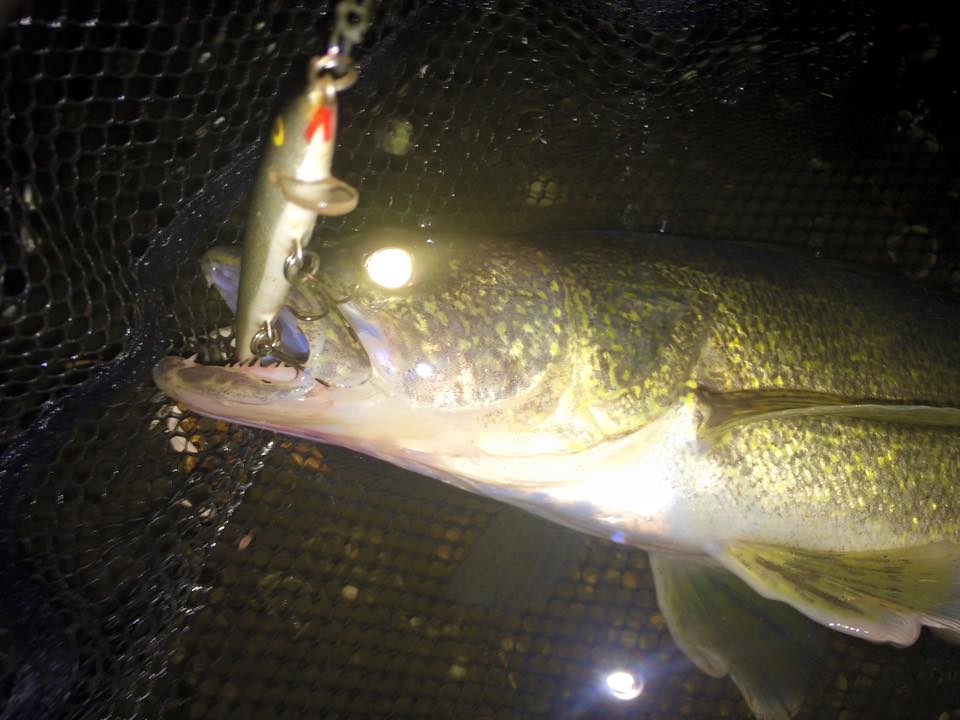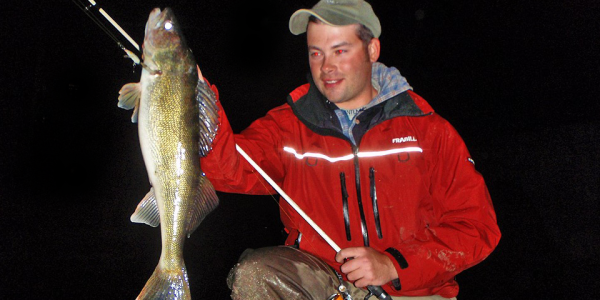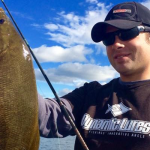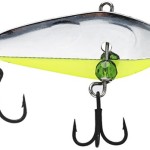By Andrew Ragas
The weather is changing. Day-by-day the water is getting colder and the fishing isn’t getting any easier. Most anglers have already winterized their boats, and are now sitting in the woods on their tree stands, or preparing for first ice. Until then, the fishing season is far from over. Big river walleyes are on the nocturnal prowl, and anglers who wade to them are reaping the rewards of following suit.
In many large Midwest river systems, walleyes are a prime target during the fall and early winter months. What most of the angling population has forgotten about is that small to medium size Midwest rivers are populated with large numbers of unmolested, unexploited walleyes that are only accessed by anglers suited up in their waders.
Although my boats were winterized more than a month ago, my season is far from over as long as the weather remains cooperative and keeps extending the fall season. I’m keeping my fingers crossed that I’ll still be catching walleyes through early December this year.
Walleyes Thrive in Barrier Free Tributaries
This late in the season, I focus all of my fishing on small and medium size rivers due to their location and my proximity to them. During my last decade of late autumn fishing, more big walleyes are caught right now than at any other time in the year. The fall migration creates a high concentration of schooling walleyes that are motivated to migrate, for feeding and overwintering purposes.
Successful walleye fisheries and their migrations require several available stream miles in order for fish to fulfill their needs for survival. Therefore rivers without barriers, and minimal dam build-up, are often the best.
Dams greatly reduce the amount of walleyes in a river system, regardless of stocking programs or not. Worst of all, they prevent seasonal fish migrations from occurring for a variety of species. In this scenario, walleyes are a victim of dams. Once they reach the impassible barrier, their migration for feeding, refuge, homing, and reproduction ceases.
Most normal river systems are comprised of great habitat ranging from hard-bottomed rock, boulder, and gravel, to stretches with sand, mud, and wood. In addition, they may have well defined channels, distinct pools and holes, and a combination of current with slackwater. Abundance of habitat is good, but cannot be fished well without an ideal water level and flow rate. These two factors are what ultimately drive walleye locations in the fall, and the specific areas I will be fishing.
Fall Walleye Location – It’s all about the Flow
Pinpointing walleye locations correlates mostly to water levels. Water temperatures are then a secondary factor. With use of USGS Streamflow apps now available for mobile devices, water levels and flow rates are more predictable now than ever before, and are updated by the hour.
The free flowing rivers that I walleye fish have a fairly low gradient of flow, with an average discharge rate (under normal water levels) of 80 to 500 cubic feet per second. In these streams, long deeper pools are often linked together with sections of shallow riffles and current runs that feature a moderate current and depth.
These rivers are best fished when current flow is stable and water levels stay consistent. Rivers are at their lowest gauge height and flow rates as autumn begins, but once the calendar creeps closer to winter, drawdowns, runoff, and snowfall will raise water levels and increase flow under normal conditions. Occasional rainfall is a benefit for fishing as long as the USGS gauge heights haven’t risen by more than a foot. The run-off from rainfall and snowfall and its receding waters thereafter initiates an intense fall bite and triggers increased feeding.
Meanwhile a heavy period of rainfall during autumn is detrimental to good walleye fishing on rivers. During these last several years, I have been unable to make any conclusions that high water levels draw higher concentrations of migrating schooling walleyes, or bring them toward upstream locations as water levels recede.
For all species of fish, flooding and increased water levels push fish tight to shore and makes river wading at night difficult and unsafe. It may even disperse the walleyes upstream or downstream from you, making them harder to catch. In fact, walleyes may even leave you for good, not to be caught again until next spring. High water will even halt your fall fishing pursuits for a few days and make the small river unfishable until it recedes to a safe level.
Being dealt with an increased river flow rate is difficult for locating walleyes as an increased flow rate changes everything, often times for the worst. Since walleyes roam the open basins of rivers and use channel edges for their migratory routes, chances for any good fishing during high water is lost. Higher water flows during the fall will hasten walleyes’ feeding and homing migrations.
Under normal river conditions, walleyes are on the move and feeding, and not homing in any specific hole or place. Being a mobile angler in waders will allow you to intercept fish in spots where their fall migration route offers them ideal feeding opportunities. Channel edges and slackwater pools are used as their resting areas, and nighttime ambush points.

The biggest thing any angler must do is to find the time to fish, and utilize it. Usually I am fishing at any point from 5 pm until as late as 10 pm.
In these small waters, walleyes make seasonal migrations as water temperatures continue to drop, and flow rates are consistent. This movement is from faster, current laced areas in early fall, to protected slackwater spots and deep pools late in the fall where fish will overwinter. The range in water temperature at this stage of the season is from 55 to 40 degrees. River walleyes seek slow current and home in deep holes, downriver pools of islands, and slackwater areas protected by gravel bars.
Some of my best walleye locations are the tail sections of larger pools. This specific area is where a deeper pool becomes shallow before it gives way into the next riffle and series of pools downstream. Tails are often accessible from shore by sand or gravel bars that extend outward into the channel and subtly deepen where it converges with the main flow. Due to a large volume of water being funneled through this shallower area, the current picks up, providing walleyes with oxygen and transporting baitfish their way. Gravel bars are my favorite natural walleye habitats, and are often nothing more than shoreline extensions that have been washed out into a river from floods and high water periods. The hard bottom substrate and depth fluctuations they create often concentrates walleyes downstream of them and sometimes upstream as well.
The size of tail-outs varies, as some may be a short distance while others more gradual. The presence of cover such as rocks, boulders, and near shore log jams increases the chances walleyes will use the area. Depths are fairly shallow, often in the 2 to 4 ft. range whereas the deeper pool that flushes into the tail may be as deep as 5 to 10 ft.
By late fall, prior to freeze-up, walleyes will congregate in slackwater holes located out of the main flow of the river’s current. These deep slackwater holes are often associated with major river bends where current carves deep depressions, troughs, and scour holes that walleyes become fixated on.
Throughout the day walleyes will hold around these locations, but they are more inclined to be active and feed during the evening twilight period, and nighttime hours.
To locate walleyes during fall, I have learned that it’s best to try fishing multiple areas throughout the night rather than rely on solely one area. Since fish are on the move, peak fishing is maximized by fishing these high percentage areas due to their likelihood of holding fish at any time. Based on my experiences, spot-hopping until fish are located is the best way to stay productive and gives anglers the best chance at consistently catching them. Fish each location thoroughly for 30 minutes up to an hour before moving on to the next location. Additionally, feeding windows that may be triggered by light levels, lunar phases, water temperature, or specific time of day are clues that tell me when and where I should fish, and for how long. Feeding windows deserve major consideration every night.
Locating and catching walleyes throughout late fall requires keying in on the types of water they use during the current conditions, and also showing them a presentation appropriate for that situation. The biggest thing any angler must do is to find the time to fish, and utilize it. Usually I am fishing at any point from 5 pm until as late as 10 pm. Unconventionally this is when air and water temperatures are at their coldest and most uncomfortable, but a time when big fish are on the move and feeding.
Go Big or Go Home
Walleyes this time of year are looking to fill their bellies, so it helps if you offer them something that would be considered big and hearty. My most important pieces of fall walleye tackle is a healthy selection of properly-tuned minnowbaits in larger than average sizes, up to 7 inches long.
In previous years, I’ve written how color style and matching the hatch plays an important role. For daytime angling, and because water clarity is much improved during the fall, I still apply this pattern. However at night, we remain without proof that walleyes can see color at night, even though science suggests that they almost certainly see color patterns during daytime. I usually stick with simple minnow patterned lures. My experiences conclude that lure profile, speed of retrieve, and lip vibration (good tuning) are more important properties of a good minnowbait than color and appearance.
River walleyes are notably drawn to long, slender lures that represent their common river foraging species of suckers, shiners, yellow perch, and shad. The minnowbait lure category includes several floating, suspending, and sinking baits, each with an individual darting action, wide wobble and vibration, flash, floating or suspending property that entices walleyes.
Suspending lures cast far. I cast 3 inch Dynamic Lures Jspecs, and moderately crank them with a straight retrieve through tail-outs, and along the deep edges of gravel bars that form pools. A steady retrieve will allow the Jspec to dive between anywhere from 2 to 4 feet depending on speed. With its wide wobble, loud internal rattle chamber, and suspending style when paused, the Jspec provokes strikes from lethargic and aggressive walleyes when they are facing upstream current and intercepting baitfish being funneled through the tail-out.
Similar to the suspending Jspec, the Rapala Husky Jerk 10 and 12 offers a slightly larger profile and a more compact, powerful wobble during the retrieve. It’s my preferred choice when targeting big walleyes, and a power cranking approach is necessary. It’s a big bait with a serious wobbling action for attracting and triggering big fish after dark. The Storm Thunderstick also offers the same.
Even though the Jspec and Husky Jerk are suspending jerkbaits, walleyes will often strike them in mid retrieve as the lure is being cranked past the hole and through the current. Jerks and pauses can be used in mid retrieve, but the technique seldom works because feeding walleyes in rivers don’t tend to follow minnowbaits without a strike. They will annihilate them.
The colder the water temperatures or tougher the conditions, the slower the retrieve speed should be. Power and vibration, and lots of jerking with the rod gets walleyes in the mood to strike. However, slow and subtle often catches the most fish. Floating minnows make this happen.
An oversize F11 (4-3/8″) and F13 (5-1/4”) Original Floating Rapala has become my most productive river lure. It’s long and slender and has high buoyancy to avoid underwater snags. Admittedly there’s nothing fancy about it because it isn’t flashy nor rattles, but its effectiveness continues to entice big river walleyes each fall season.
Walleyes strike the F13 with a slow and steady retrieve without any pauses. It’s a simple, boring presentation, but gets the job done for me in darkness. Big baits like this give fish the opportunity to feel it, see it, track it, and eat it. There’s greater probability for walleyes to feel and see a bigger bait at night rather than a downsized one. When walleyes strike the F13, there’s more bait and sets of treble hooks for them to hit and less chance for error.
It is important to make long casts perpendicular and downstream with the current flow of the river when fishing with minnowbaits. Sometimes with the F13, I bomb cast the minnow as far downstream as I can, and retrieve it back upstream where it can follow the path of the channel edge that walleyes will travel along. With any minnowbait, retrieving the lure at a steady pace and exerting its wobble and vibration triggers strikes. If there is current, let it do most of the work during the retrieve and slow down your reeling and cranking.

The hardbait minnow family has grown extensive. Each style I carry in my wading satchel has its time and place at various points throughout my fall river fishing adventures. With so many styles and designs infiltrating store shelves, it’s best to experiment until you find a particular style or brand that the walleyes in your river want. The noted baits above are all I need on any given night.
A properly presented lure is everything for river walleyes at night. A few modifications I make to my minnowbaits are using cross lock snap swivels for quick lure changing. Additionally, I attach split rings to the bait’s eyelet. Floating minnows such as the F11 and F13 Rapalas I fish with do not feature a split ring eyelet directly from the package. Split rings provide the minnow a better wobble under most retrieve speeds, keeps it running tuned longer, and gives hooked walleyes less leverage to throw the bait as they thrash the surface during the fight.
For all minnowbait techniques this season, I’ve grown to enjoy fishing with Quantum PT’s Accurist spinning rods. At a 7 ft. length with fast action, and labeled for medium heavy applications and lines of 10 to 17lb, the rod is more flexible than most other rods in its size class, and has a unique soft tip section that aids me in detecting strikes from near and far casting distances. Its longer length allows me to bomb casts when needed, and is balanced well to support lighter and smaller reels that force me to slow down the retrieve speed. Paired with a size 20 Quantum Catalyst PT spinning reel spooled with 8lb Cortland Endurance monofilament in high-vis orange, I am supported with strength and control of the line. With the downsized reel, I have an ideal 5.2:1 gear ratio that keeps my retrieve speed honest in order to present my minnowbaits to walleyes without much error to my technique.
In order to get there at night, waders that don’t leak helps. Then all that’s needed is the understanding of water level and current flow and how it manipulates and regulates stream walleye locations. As the open water season dwindles down to the beginning of winter and ice fishing season for most others, there’s no better way for me to enjoy the fall season and what remains of it.









